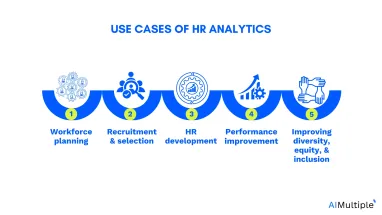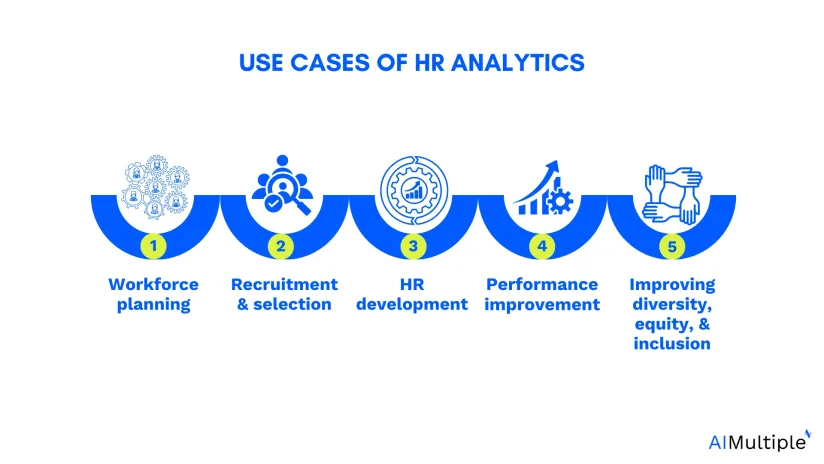By leveraging predictive models, descriptive analytics, and people analytics, HR teams can gain actionable insights into employee behavior, engagement, and performance, helping to align HR initiatives with broader business objectives.
Explore key 5 HR analytics use cases across workforce planning, recruitment, training, and performance improvement to demonstrate the impact of data on enhancing organizational outcomes:
Top 5 use cases of HR analytics
1. Workforce planning: shaping the future workforce
Effective workforce planning is critical for ensuring the right talent is positioned in the right roles to achieve business success. Through diagnostic analytics, HR professionals can analyze data points like labor market trends, employee demographics, and historical workforce data.
Use cases
- Identify skill gaps: Organizations like the Mexican Ministry of Energy have successfully leveraged HR analytics to pinpoint current and future skill gaps, aligning workforce capabilities with industry demands and attracting stakeholder investment.1
- Predict long-term workforce supply and demand: Predictive analytics in workforce planning allows organizations to forecast labor needs, ensuring they have the right skills at the right time through strategic decisions to “buy, build, or borrow” talent.2
- Develop targeted retention strategies: Using HR data and predictive modeling, companies such as Credit Suisse have identified high-turnover risks, enabling the creation of effective retention strategies that improve employee satisfaction and reduce costly attrition.3
Key insights
Analytics can help HR identify essential skills needed for future roles, enabling data-driven decisions that reduce turnover and improve business outcomes.
2. Recruitment and selection: streamlining talent acquisition
HR analytics enhances the recruitment process by optimizing how organizations attract and select the right talent. By combining machine learning algorithms with employee data, HR teams can predict a candidate’s potential and improve people analytics processes.
Use cases
- Expand the candidate pool: Leveraging HR analytics to analyze data from social media and CVs allows organizations to identify diverse and skilled candidates, broadening the talent pool while aligning with targeted recruitment strategies.
- Implement AI-assisted interviews: By employing AI tools, organizations can better match candidate skills and aspirations with job roles, improving hiring precision and long-term business outcomes.
- Analyze historical data: By using historical employee data, organizations may refine the hiring process and identify competencies that drive business performance: Using historical employee data and learning insights, companies like Lockheed Martin optimize recruitment by identifying competencies linked to high performance, fostering a data-driven approach to talent acquisition.4
Key insights
Predictive analytics ensures a seamless talent acquisition process while identifying candidates likely to succeed, reducing time-to-hire, and enhancing business outcomes.
3. HR development: enhancing employee skills and engagement
Training and development programs are essential for building a skilled workforce. HR analytics tools can track employee performance metrics and assess the correlation between training initiatives and job satisfaction.
Use cases
- Provide recommendations: AI-powered tools enable HR professionals to tailor training programs to individual needs by analyzing performance data, ensuring employees receive relevant learning opportunities that align with their goals and organizational objectives.
- Evaluate the effectiveness of training programs: By analyzing employee feedback from surveys and using diagnostic analytics, companies like Lockheed Martin identify training programs that significantly impact employee satisfaction and overall performance.5
- Support leadership development initiatives: Organizations like Google and POSCO utilize HR analytics to process structured and unstructured employee data, identifying critical leadership traits and guiding leadership development programs that strengthen organizational performance.6 7
Key insights
Analytics can help HR professionals design cost-effective training programs that enhance employee engagement and foster a positive work environment, driving long-term business success.
4. Performance improvement: aligning HR strategy with business goals
Performance management is a key area where HR analytics creates measurable value. By analyzing employee performance data, HR departments can identify factors that influence employee engagement and productivity.
Use cases
- Detect employee sentiment: Organizations can use sentiment analysis tools to gather employee feedback on workplace experiences, enabling HR professionals to proactively address dissatisfaction and improve work environments. These insights, collected through surveys and feedback channels, help foster a positive organizational culture that supports employee engagement and overall satisfaction.
- Identify negative elements affecting employee outcomes: By leveraging internal social media data and sentiment analysis, organizations identify cultural weaknesses and their impact on business performance, thereby informing strategies for leadership communication and workplace improvements.8 Ethical considerations, including privacy concerns, must be addressed to ensure employees feel safe contributing to such analyses.
- Link compensation and benefits to performance trends: HR analytics enables organizations to identify correlations between compensation structures and employee outcomes, as seen in JP Morgan Chase’s use of workforce data to drive retention strategies and enhance employee experience.9 By analyzing performance trends, HR leaders can design equitable and motivating compensation packages, contributing to reduced turnover and higher employee satisfaction.
Key insights
By tracking key metrics, HR leaders can implement data-driven retention strategies and foster a positive work environment, ensuring employees feel valued and motivated.
5. Improving diversity, equity, and inclusion (DEI): a fair workplace
HR analytics plays a pivotal role in advancing diversity, equity, and inclusion by providing data-driven insights to identify and address disparities within organizations. Through descriptive and predictive analytics, HR professionals can track key metrics related to employee demographics, equity in promotions, and representation across leadership roles.
Use cases
- Analyze workforce demographics: By leveraging HR analytics, organizations like the Public Service Commission of New South Wales in Australia have successfully monitored and tracked diversity metrics, setting measurable goals, such as increasing women’s representation in senior roles by 50% by 2025.10
- Design targeted DEI strategies using employee data: Case studies, such as those from the Australian public sector, show how analytics can assess salary bands, representation rates, and talent pipelines for underrepresented groups, enabling tailored strategies to promote equity and inclusion in leadership.11
- Monitor and measure progress toward DEI goals: Using longitudinal workforce data, organizations can evaluate the effectiveness of DEI initiatives and adjust strategies to align with their objectives, fostering an inclusive culture and ensuring accountability.
Key insights
Quantitative data from HR analytics enables organizations to develop transparent and actionable DEI policies, enhancing equity across all levels while promoting an inclusive and diverse workplace.
Further readings
- AI HR Analytics: Use Cases, Benefits & Challenges
- HR Analytics Tools: List, Use Cases & Challenges
- Top 15+ Employee Monitoring Software
FAQs
What are the benefits of HR analytics?
HR analytics and tools designed for HR data analytics can help for:
Enhanced decision-making: HR analytics empower organizations to make informed decisions about hiring, promotions, training, and retention strategies. Historical data and trends help predict outcomes and optimize HR policies.
Increased employee retention: By analyzing turnover trends and understanding employee satisfaction, organizations can implement targeted interventions to reduce attrition. For example, companies like Nielsen have improved retention rates by using HR analytics to identify at-risk employees and take proactive measures.
Improved productivity and performance: HR analytics pinpoint barriers to productivity and suggest areas for resource allocation, ensuring employees and teams reach their full potential. They help design incentive programs and assess their effectiveness in driving performance.
Cost savings: Data-driven hiring reduces recruitment costs by focusing efforts on high-impact hires. Identifying inefficiencies in training and compensation structures can lead to substantial savings.
Scalable workforce planning: With predictive analytics, organizations can anticipate future needs and strategically scale their workforce without over- or under-investing in talent acquisition.
Compliance and risk mitigation: Advanced data security features ensure sensitive employee information is protected, reducing the risk of breaches and legal repercussions.
What are the challenges of HR analytics implementation?
Implementing HR analytics tools and solutions comes with significant challenges that can hinder HR teams from leveraging employee data to drive data-driven decisions and improve workforce planning. Key challenges include:12 Data integration and quality: HR data often exists across multiple sources, creating issues with seamless data integration and data inconsistencies. Poor data quality can lead to unreliable key metrics, such as employee turnover and performance metrics.
Limited analytics skills: Many HR professionals lack expertise in data analysis and statistical methods, hindering their ability to derive valuable insights from HR analytics tools.
Privacy and compliance: Collecting and analyzing workforce data must comply with privacy regulations, such as GDPR. Ensuring data security and building trust with employees is crucial for successful adoption.
Top management support: A lack of support from senior leaders can undermine investments in analytics software and the promotion of a data-driven culture.
Complexity of tools and models: Deploying advanced models and presenting insights through visualization tools can be challenging. Intuitive, user-friendly interfaces help simplify the process and enhance adoption.
External Links
- 1. The Path to Becoming a Data-Driven Public Sector | OECD.
- 2. KIRD. 2021. R&D HRD Trend Report, People Analytics. Seoul: Korea Institute of Human Resources Development in Science and Technology.
- 3. Top 50 Big Data Statistics in 2025: Market Size & Benefits. AIMultiple
- 4. Klimoski, Richard, Karen B. Paul, Coretha M. Rushing, Sara Rynes, Mark J. Schmit, James R. Schultz, and Jose Tomas. 2016. Use of Workforce Analytics for Competitive Advantage. SHRM Report, 1–38.
- 5. Klimoski, Richard, Karen B. Paul, Coretha M. Rushing, Sara Rynes, Mark J. Schmit, James R. Schultz, and Jose Tomas. 2016. Use of Workforce Analytics for Competitive Advantage. SHRM Report, 1–38.
- 6. Kim, Yonggeun, Jeong O. Seo, and Woo Jae Choi. 2020. A Case Study ‘Recommendation System for Leader Selection’ of HR Analytics Application: Focus on Agency Theory. Korean Journal of Business Administration 33: 1625–45.
- 7. Shrivastava, Shweta, Kritika Nagdev, and Anupama Rajesh. 2018. Redefining HR using people Analytics: The case of Google. Human Resource Management International Digest 26: 3–6.
- 8. Gelbard, Roy, Roni Ramon-Gonen, Abraham Carmeli, Ran M. Bittmann, and Roman Talyansky. 2018. Sentiment analysis in organizational work: Towards an ontology of people analytics. Expert Systems 35: e12289.
- 9. Cho, W., Choi, S., & Choi, H. (2023). Human resources analytics for public personnel management: Concepts, cases, and caveats. Administrative Sciences, 13(2), 41.
- 10. The Path to Becoming a Data-Driven Public Sector | OECD.
- 11. Ghosh, Shameek, Yi Zheng, Thorsten Lammers, Ying Ying Chen, Carolyn Fitzmaurice, Scott Johnston, and Jinyan Li. 2016. Deriving public sector workforce insights: A case study using Australian public sector employment profiles. In Lecture Notes in Computer Science, 10086 LNAI. Cham: Springer, pp. 764–74.
- 12. Opatha, H. H. D. P. J. (2020). HR analytics: a literature review and new conceptual model. International Journal of Scientific and Research Publications (IJSRP), 10(06), 130-141.




Comments
Your email address will not be published. All fields are required.